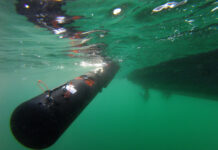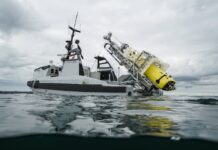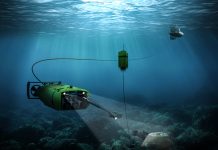Providing sustained presence on station at depth below the surface is a role that sits neatly with uncrewed underwater vehicles. For emerging operational requirements such as seabed warfare, autonomous underwater vehicles and remotely operated vehicles combine to generate surveillance and response for this task.
Seabed warfare is a new element to the maritime underwater domain, or perhaps even a new domain altogether. Whether to secure or attack critical undersea infrastructure (CUI) such as oil and gas pipelines or communications/data/power cables, whether to secure or exploit seabed resources, or whether to use the seabed to search for or deploy sensors or weapons when shaping the operational battlespace, uncrewed underwater vehicles (UUVs) will provide core capabilities for navies. There are two primary UUV types – remotely operated vehicles (ROVs), and autonomous underwater vehicles (AUVs).
In February 2024, reports emerged that several CUI cables running from Saudi Arabia to Djibouti across the southern Red Sea’s seabed had been disrupted. The Red Sea is of course currently a focus for high-intensity naval operations. Multinational naval forces are assembled to provide air-defence and anti-surface warfare cover for commercial and naval shipping transiting the Gulf of Aden/Bab-el-Mandeb Straits/Red Sea corridor under the threat of air and surface attack from Yemen-based Ansar Allah (Houthi) rebels launching ballistic and cruise missiles along with uncrewed aerial vehicles (UAVs) and uncrewed surface vessels (USVs).

Credit: IAI
Senior military officers have also asked whether a small but prominent uptick in Somali piracy in the Gulf of Aden may be linked to Houthi activities across the water. Similarly, defence analysts have asked whether the Houthis themselves might have developed the capability to conduct seabed operations using UUVs, and have been responsible for these latest attacks.
The current Russia-Ukraine and Israel-Hamas wars, alongside the Red Sea shipping crisis, are all demonstrating not only the use of uncrewed systems – something not even major navies have yet done with any regularity and mass – but their use in innovative ways.
As regards seabed warfare and the role of UUVs, operating on the seabed itself – including at depths down to 6,000 m – is a significant technological and operational challenge. However, the increasing availability of technologies such as UUVs (including both AUVs and ROVs), is opening up the prospect that both state and non-state actors could operate to significant effect on the seabed, in either littoral or blue-water operational contexts.
The Red Sea cable incident is the latest in several high-profile events involving disruption to seabed CUI. In October 2023, the Balticconnector gas pipeline running between Estonia and Finland, plus a nearby telecommunications cable, were disrupted by what was widely reported as a Chinese commercial vessel dragging an anchor across the seabed. In September 2022, the two Nordstream gas pipelines that dissect the Baltic Sea were ruptured by explosions. NATO and countries in the region attributed the incident to sabotage.
In January 2022, at the northern end of the maritime dividing line between the Norwegian and Barents seas, fibre-optic cables connecting the SvalSat Satellite Ground Station on Norway’s Svalbard archipelago to the Norwegian mainland were damaged. Local media reports said that Norwegian investigations indicated human involvement.
In November 2021, it was reported that a sub-surface environmental sensing network on the seabed off the Lofoten peninsula, in northern Norway, had been taken offline due to more than 4 km of its fibre-optic sensing cable being ripped out. The Lofoten peninsula sits at the southern end of the Norwegian/Barents seas maritime junction, and would be a busy location for submarines seeking to slip around the North Cape at the bottom of the Bear Island Gap. The sensor network, owned and operated by the Norwegian Institute of Marine Research’s civilian Lofoten-Vesterålen (LoVe) Ocean Observatory, likely could detect maritime traffic as well as monitoring environmental matters.

Credit: US Navy
The range of causes potentially relevant in these five different incidents includes the possible use of explosives (as in the Nordstream and Red Sea cases), with such explosives potentially deployed by an ROV; an anchor dragged, accidentally or otherwise (as in the Balticconnector case); and a UUV – likely an ROV – used to damage a cable (as in the Svalbard case), and to grip and drag a significant length of cable, including ripping it from concrete moorings (as in the Lofoten case).
Instances where a cable or pipeline may have been blown up or ripped out indicate potentially the involvement of a UUV fitted with a manipulator arm that can conduct, effectively, ‘ditch or retrieve’ manoeuvres.
Across these five incidents, water depths range from: tens of metres to over 400 m through the Bab-el-Mandeb straits at the southern end of the Red Sea; to around 200 m in the Baltic Sea and off the Lofoten peninsula; to as deep as 2,700 m off Longyearbyen, Svalbard.
Some Western navies are developing the capacity to conduct seabed warfare operations at depths of up to 6,000 m. The ability to operate at such depths means these navies can conduct seabed operations across the North Atlantic almost in its entirety.
Twin requirements
The Baltic and Red Sea incidents related to CUI. The two incidents in Norwegian waters related to commercial sensor and communications cables that could gather and transmit information that could in turn be used to shape situational awareness for Norway and its allies. For example, according to media reports, data gathered by the LoVe Ocean Observatory is shared with the Norwegian Ministry of Defence (MoD).
These two separate types of incident reflect navies’ own operational requirements prospectively to conduct two separate types of seabed warfare. The first type would be to secure commercial and military CUI from a defensive perspective – operations which may likely take place in national territorial waters or exclusive economic zones. The second type would be to monitor and sanitise – or ‘de-louse’ – the seabed, looking for sensors or ordnance that may have been placed to threaten naval freedom of manoeuvre, or looking to deploy sensors or ordnance to threaten another navy’s freedom of manoeuvre. The latter type of operations could occur wherever a navy’s area of interest might be around the world.
By way of example, at the Portuguese Navy/NATO Maritime Command co-led ‘REPMUS’/‘Dynamic Messenger’ maritime uncrewed systems (MUS) exercise in southern Portugal in September 2023, a UUV was used to conduct over-the-horizon intelligence, surveillance, and reconnaissance (ISR) in support of a mine counter-measures (MCM) operation intended to ‘de-louse’ a seabed ‘corridor’ to enable an amphibious assault ashore. The operation needed to be conducted covertly, so as not to signal the impending amphibious operation: UUVs – especially AUVs – play a critical role in generating such covert access, and doing so at distance with the required level of autonomy. The UUV used was a Teledyne Gavia AUV, taken to the exercise by the Royal Danish Navy.

Credit: US Coast Guard
Developing seabed warfare capability, for either defensive or offensive operations, is something navies can sometimes be sensitive to talking about, reflecting the fact that navies operating regularly in the opaque underwater world prefer to mask their activities there. However, one navy talking openly about, and demonstrating in operations, how it is looking to conduct seabed warfare (both defensive and offensive) and around the world (in both littoral and blue-water contexts) is the French Navy.
Calliope Operations
In October 2022, the French Navy established a new, bespoke seabed warfare operation called ‘Calliope’. Four ‘Calliope’ deployments – what the navy refers to as Maitrise des Fonds Marins (MFM) operations, or deep-sea control – have now taken place, the most recent of which occurred in October 2023 in the Atlantic Ocean. The navy conducts ‘Calliope’ operations in conjunction with France’s defence procurement agency, the Delegation Générale de l’Armaments (DGA).
In a 15 October 2023 social media post on X (formerly Twitter), the French navy said the latest ‘Calliope’ operation built on developments carried out in the three previous activities, relating to the use of AUVs and ROVs. Rear Admiral Cedric Chetaille, the navy’s deputy chief for operations and the senior officer responsible for seabed warfare operations and capabilities, discussed the latest ‘Calliope’ deployments and the wider seabed warfare context in two posts on X, on 10 October and 16 October 2023 respectively. First, he noted that the seabed is a new domain for hybrid conflict and other matters that can have strategic outcomes; second, regarding ‘Calliope’, he said “the French Navy continues with the successful development of its capacity to monitor the deep sea and to act on the seabed.”
Back in February 2022, the French Navy published its seabed warfare strategy, in which it stipulated the requirement to deliver capability to operate on the seabed at depths of up to 6,000 m by 2026. Requirements such as this as set out in the strategy are shaping the developmental focus of the ‘Calliope’ operation. In a short report published in November 2023, the French MoD said “The freedom of action of our forces at sea therefore depends heavily on our ability to control the depths.”
In the report, Rear Adm Chetaille outlined the core contributions of AUVs and ROVs in seabed operations and control, encompassing the development of knowledge of the seabed, plus the capacity to monitor and to act. AUVs help build knowledge and surveillance; ROVs provide capability to surveil and react, the admiral explained.

Credit: Canadian Armed Forces
In the first ‘Calliope’ activity, in October 2022, the oceanographic and hydrographic survey vessel FS Beautemps-Beaupré deployed to the Bay of Biscay carrying onboard a Kongsberg Maritime HUGIN Superior AUV. The AUV, which has the design capability to deploy down to 6,000 m, was tested down to 4,500 m during ‘Calliope’. In the first half of 2023, two ‘Calliopes’ occurred. The first, off the coast of Brest on France’s west coast, involved the offshore support vessel FS Garonne. The second, in the Mediterranean Sea, involved deploying the Exail A18-D AUV down to 3,000 m.
Within the context of the navy’s seabed warfare strategy and under France’s latest Loi de Programmation Militaire (LPM), which is covering the 2024-30 period, the navy is aiming to manufacture its own AUVs and ROVs by 2026, based on the systems it has been testing in ‘Calliope’. Such systems, the MoD report said, will be designed to give France sovereign capabilities for controlling the seabed.
The report noted that France’s research institute for maritime exploration has been working with Exail to develop the capabilities of the ULXy deep-water AUV, adding that the system could meet the capability and operational requirements for France’s deep-water AUV with its capacity to deploy down to nearly 6,000 m.
Exail Technologies – formed when ECA Group and iXblue joined forces in 2022 – refers to A18-D as a mid-sized AUV (with a 5.5 m maximum length, and a 690 kg maximum weight) designed for deep water applications down to 3,000 m, optimised for CUI survey work, and able to perform autonomous missions with a 24-hour endurance. Sensing capability includes a sub-bottom profiler, side-scan and forward-looking sonars, and a multi-beam echo sounder; its flexibility in sensor payloads is demonstrated by the fact that it has an option to fit a synthetic aperture sonar (SAS), too. The system is air-transportable (via shipping container, with this containerized capability including the AUVs’ command-and-control [C2] link), is deployed via launch-and-recovery system (LARS) to deliver autonomous underwater recovery, and comes with data processing software installed.
Kongsberg’s HUGIN Superior’s capabilities for monitoring the seabed include a sub-bottom profiler, SAS and multi-beam echo sounders in its sensor package; autonomous pipeline tracking via the SAS capability; enhanced positioning through its High Precision Acoustic Positioning (HiPAP) system; automatic target recognition capability; and long endurance on station and/or wider seabed coverage. According to the company, the AUV’s seabed imagery coverage rate is roughly 4.5 km2 per hour. Kongsberg added that the system’s level of autonomy means its host platform can be released to conduct concurrent activities. The 6.6 m, 2,200 kg HUGIN Superior is deployed with C2 and LARS systems, plus post-mission analysis software.
Containerised capability
France’s approach to developing seabed warfare capability that can be containerised and rapidly deployed where and when required reflects the wider approach of other NATO countries, and NATO itself, to develop capability that can be used to deter and defend against the seabed warfare threat.
At ‘REPMUS’/‘Dynamic Messenger’, alongside testing the utility of AUVs in sanitising forward operating areas to enable the entry of follow-on forces, NATO navies also tested the utility of AUVs and ROVs in deterring and defending against risks to CUI. In a scenario demonstrated at sea during the exercise’s Distinguished Visitors’ (DV) Day, a layered collection of uncrewed systems was tasked to respond to a state-based threat to seabed cables that involved the use of some hybrid warfare tactics. NATO’s integrated response layers in the exercise included UAVs conducting surveillance of the operating area, USVs deploying AUVs, and several ROVs and AUVs that were present to sense and respond to the CUI threat.
A senior NATO official told a media briefing at the DV Day that the results of the live scenario and the wider testing of UUVs during the exercise may feed into the development of concepts and capabilities that could form part of a containerised CUI protection ‘system of systems’ that could be generated as a deployable, rapid-response option.
NATO and its member-state navies have already developed and deployed containerised capability for MCM operations, with both AUVs and ROVs included here. Other areas of focus for developing containerised capability include humanitarian assistance and disaster relief (HADR) and anti-submarine warfare (ASW) – the latter again including UUVs.
One navy developing a platform designed specifically to embark AUV and ROV capabilities for seabed warfare, and particularly in containerised format, is the UK Royal Navy (RN), through its Royal Fleet Auxiliary (RFA) vessel Proteus.

Credit: Crown Copyright 2023
Proteus is one of two dedicated platforms the RN is procuring under the multi-role ocean surveillance ship (MROSS) programme to provide capacity to address CUI threats. While the second ship in the programme could be either custom-built or market-bought, Proteus (formerly named Topaz Tangaroa) was procured off-the-shelf from the commercial offshore support vessel market to enable delivery of such capability into service as soon as possible. Following the announcement of the planned procurement, the ship arrived in January 2023, was commissioned in October 2023, and is currently completing customisation as an RFA asset: it sailed from the Cammell Laird shipbuilding yard on 12 March 2024, and arrived at HM Naval Base Devonport two days later.
“The UK is being really clear that we’re procuring a vessel that is capable of protecting our sovereign CUI,” RN Second Sea Lord Vice Admiral Martin Connell told the annual Combined Naval Event (CNE) conference in Farnborough, UK in May 2023.
Capacity to carry containers and deploy AUVs and ROVs onboard Proteus is enabled by the ship’s design. According to Janes Fighting Ships, relevant spaces, systems, and equipment for the embarkation and operation of containerised AUV and ROV capabilities include a 120 tonne offshore crane; a 1,000 m2 working deck; a large hangar; a moonpool; and dynamic positioning capability. While the RN has not said much publicly about the kinds of capabilities Proteus will embark, in September 2023 it was announced that the UK MoD had contracted Danish subsea engineering company Eiva to supply its ScanFish L remotely operated towed vehicle (ROTV).
According to a statement released by the company, ScanFish L will be part of the RN’s ‘system of systems’ approach for seabed warfare, with the system bringing together a collection of acoustic sensors and other instruments that can be deployed from different platforms. The statement noted that ScanFish L’s particular contribution to this ‘system of systems’ is, broadly, oceanographic survey and data collection, including: seabed mapping; wide-area search; CUI monitoring such as pipeline inspection and cable route survey; and MCM operations. To conduct these and other operations, the ScanFish L sensor package includes Sonardyne’s SPRINT-N inertial navigation system/doppler velocity log, and two Voyis systems – the Observer Pro optical camera, and Insight Pro laser scanner.

Credit: Eiva
The ScanFish L capability will be provided to the RN in containerised format, using a modular container from Danish company SH Defence. The container will come fitted with two dedicated workstations, meaning ScanFish can be fully integrated and operated without needing to be plugged into the ship’s C2 system. According to Eiva, “This solution will provide integrated and enhanced operational capabilities for the RN, demonstrating both modularity in the ScanFish setup and flexibility of employment through the containerised solution.”
Containerisation is a core concept supporting the effective embarkation, deployment, and operation of AUVs and ROVs at sea. Containerised concepts have been developed by navies for two primary reasons. Containerising capability provides navies with an opportunity to bring a ship into port mid-mission to add a capability the ship may need in response to an urgent operational requirement, or a ship can be fitted out with a container prior to deploying for a mission to provide it with a capability not carried organically.
Both approaches generate the option for navies to deploy AUVs and ROVs relatively rapidly in response to operational requirements, and to spread such capabilities across naval force structures without needing to embark them organically on every ship.
Dr Lee Willett








